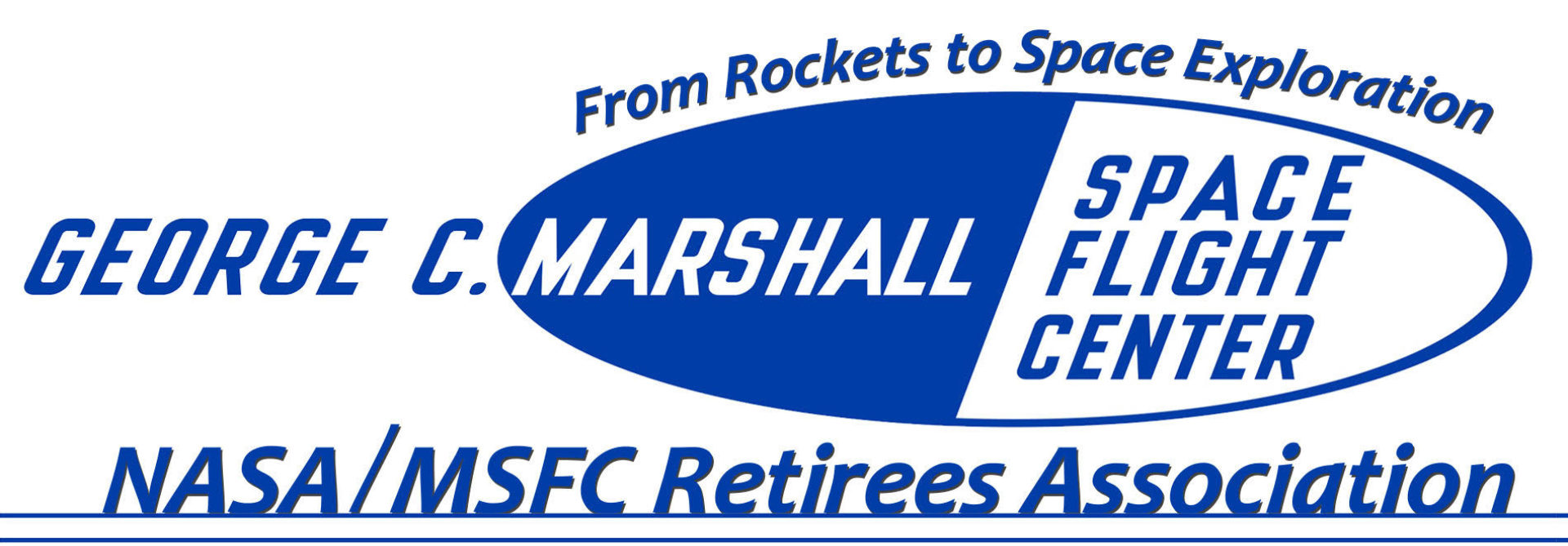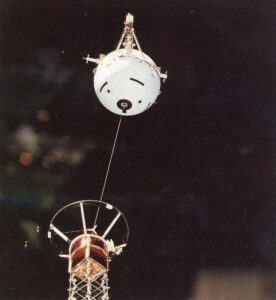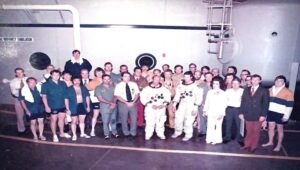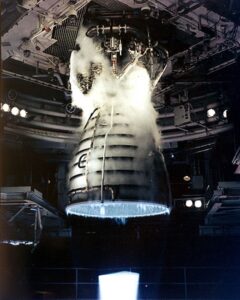Dr. Alexander J Dessler served as Director of the Space Science Laboratory at Marshall Space Flight Center from 1982 to 1986. The following life story was published at the time of his death in 2023.

T. W. Hill
Alex Dessler passed away at age 94 on April 9, 2023. He was born on October 21, 1928, in San Francisco, CA. He earned his B.S. in physics at the California Institute of Technology in 1952 and his Ph.D. in physics at Duke University in 1956. He then became, over time, a founding father of space science research and education in the United States and in the world.
During his postdoctoral years 1956-62 Dessler was a senior scientist at the Lockheed Missiles & Space Co. in Palo Alto, CA. The U.S.–U.S.S.R. race to put a man on the Moon in the 1960’s motivated Rice University president Kenneth Pitzer to bid for the country’s first university department of Space Science, and to hire Alex Dessler to become that department’s architect and founding chair. Dessler chaired the new department from 1963-69 and again in 1979-82 and 1987-92. The department was re-named Space Physics & Astronomy in the 1970’s. Dessler brought the Keller method of self-paced instruction to the Rice campus and demonstrated its utility in college-level science teaching. He took leave of absence from Rice during 1982-86 to successfully direct the Space Science Laboratory at NASA’s Marshall Space Flight Center in Huntsville, AL. Otherwise, although he travelled widely, Dessler stayed with Rice until his retirement from the teaching faculty in 1993.
In 2000 the Space Physics & Astronomy department was absorbed by the much larger Physics department to produce today’s even larger Physics & Astronomy department. After his Rice retirement Dessler took a Research position at Univ. AZ to continue his fruitful collaboration with Prof. Bill Sandel (Rice Space Science Ph.D., 1972), the Voyager 1 and 2 ultraviolet detector investigator. When the time came for Alex to really (sort of) retire in 2007, he moved to Bryan, TX to accept an adjunct professorship at TX A&M Univ., where his son Andrew was and is a professor in the Atmospheric Science Department.
In the late 1950’s Dessler set off on a research career to study the behavior of magnetized plasmas in space, using insights gained from the relatively new science of magnetohydrodynamics (MHD). In the paper by Dessler (1959) he elucidated how the non-dipolar “anomalies” in Earth’s surface magnetic field carve out measureable holes in the velocity-space distributions of energetic charged particles trapped in Earth’s Van Allen radiation belts. (Literature citations are given in the appended list of selected publications.) More than a mere curiosity, these “magnetic anomaly” effects provide critical tools for analyzing the dynamics of Earth’s magnetosphere. The same dynamics reappeared with new relevance 15 years later when the focus of Dessler’s studies switched from Earth’s magnetosphere to Jupiter’s (Dessler & Hill, 1975).
In the same year, Dessler & Parker (1959) summarized the available empirical knowledge of the geomagnetic storm phenomenon known to science since Gauss’s studies of geomagnetism in the nineteenth century, and offered a comprehensive physical theory of the storm phenomenon based on the recently discovered principles of MHD. Applications of this storm theory led to innovative estimates of the maximum particle energy content of Earth’s radiation belts (Dessler & Vestine, 1960), and of the energy source provided by geomagnetic storms to power Earth’s magnificent auroral displays, called the aurora borealis/australis at northern/southern high latitudes.
The classic review paper by Dessler (1967) summarized and analyzed the historical evolution of ideas about the solar wind and its embedded interplanetary magnetic field. It also introduced the concept of the heliosphere (and coined its name), described the formation of corotating interaction regions (CIRs) within the solar wind, bounded by forward and reverse collisionless shock waves (Dessler and Fejer, 1963), and described the termination of the solar wind at its outer boundary, the heliopause (Axford, Dessler, and Gottlieb, 1963).
Dessler and his first graduate student David Cummings (Cummings and Dessler, 1967) showed that new satellite observations of magnetic field fluctuations at high latitudes are best explained by the magnetic-field-aligned electric currents hypothesized in 1908 by Norwegian explorer and physicist Kristian Birkeland. This was a momentous discovery for auroral physics, and it inspired Dessler (1984) to introduce his American and British colleagues to the fundamental discoveries of Birkeland near the turn of the century and of Swedish plasma physicist Hannes Alfvén (Physics Nobel Prize, 1970) during the following half century. The physics behind these Birkeland currents was elucidated by Dessler and published by Schield, Freeman and Dessler (1969).
The role of ionospheric conductivity in regulating the flow of the solar wind around Mars was elucidated by Dessler (1968) and generalized to Earth and Venus by Hill, Dessler & Wolf (1976). These ideas figured prominently in many later studies of the flow of magnetospheric plasma past conducting planetary satellites like Io at Jupiter (e.g., Dessler, 1980) and Enceladus at Saturn, as well as the rate and pattern of plasma “convection” (systematic motion) within a planetary magnetosphere.
Shortly after the first spacecraft encounter with Jupiter (Pioneer 10 in December 1973), Hill, Dessler & Michel (1974) elucidated many of the observable features of a rotation-dominated planetary magnetosphere that were exhibited first by Jupiter and much later by Saturn. Dessler & Hill (1975) extended the magnetic-anomaly model that Dessler (1959) had developed for Earth, to Jupiter, where the effects of the magnetic anomaly are far more dramatic and decisive. Dessler (1980) also pointed out the likely dominance of planetary satellites over the solar wind or planetary ionosphere as plasma sources for a planetary magnetosphere, particularly for a rotation-dominated magnetosphere like those of Jupiter and Saturn. He coined and popularized the term “one ton/second” for Jupiter’s magnetospheric plasma source rate provided by its volcanically active satellite Io.
Finally, Dessler & Vasyliūnas (1979) and Vasyliūnas & Dessler (1981) provided a masterful demonstration of the traditional scientific method at work. In the 1979 paper they gave a detailed set of theoretical model predictions for the forthcoming Voyager 1 encounter with Jupiter, and in the 1981 paper they gave an objective scorecard after the fact. Never mind the score; the important point is, that’s how science works when it works best.
Alex Dessler was preceded in death by his daughter Valerie Dessler Greider (1957-2015) and his wife Lorraine Dessler (1928-2021). He is survived by sons David and Andrew, daughter Pauline, five grandchildren, and three great-grandchildren. He will be remembered fondly by all who knew him.
Selected Publications of A. J. Dessler (of 109 refereed, 175 total)
Dessler, A. J., Effect of magnetic anomaly on particle radiation trapped in geomagnetic field, J. Geophys. Res., 64, 713, 1959.
Dessler, A. J. and E. N. Parker, Hydromagnetic theory of geomagnetic storms, J. Geophys. Res., 64, 2239, 1959.
Dessler, A. J. and E. H. Vestine, Maximum total energy of the Van Allen radiation belt, J. Geophys. Res., 65, 1069, 1960.
Dessler, A. J. and W. B. Hanson, Possible energy source for the aurora, Astrophys. J., 134, 1024, 1961.
Axford, W. I., A. J. Dessler, and B. Gottlieb, Termination of solar wind and solar magnetic field, Astrophys. J., 137, 1268, 1963.
Dessler, A. J. and J. A. Fejer, Interpretation of Kp index and M-region geomagnetic storms, Planet. Space Sci., 11, 505, 1963.
Cummings, W. D. and A. J. Dessler, Field-aligned currents in the magnetosphere, J. Geophys. Res., 72, 1007, 1967.
Dessler, A. J., Solar wind and interplanetary magnetic field, Rev. Geophys. 5, 1, 1967.
Dessler, A. J., Ionizing plasma flux in the Martian upper atmosphere, The Atmospheres of Venus and Mars, London, Gordon and Breach, 241, 1968.
Schield, M. A., J. W. Freeman, and A. J. Dessler, A source for field-aligned currents at auroral latitudes, J. Geophys. Res., 74, 247, 1969.
Hill, T. W., A. J. Dessler and F. C. Michel, Configuration of the Jovian magnetosphere, Geophys. Res. Lett., 1, 3, 1974.
Dessler, A. J. and T. W. Hill, High-order magnetic multipoles as a source of gross asymmetry in the distant Jovian magnetosphere, Geophys. Res. Lett., 2, 567, 1975.
Hill, T. W., A. J. Dessler and R. A. Wolf, Mercury and Mars: The role of ionospheric conductivity in the acceleration of magnetospheric particles, Geophys. Res. Lett., 3, 429, 1976.
Dessler, A. J. and V. M. Vasyliūnas, The magnetic anomaly model of the Jovian magnetosphere: Predictions for Voyager, Geophys. Res. Lett., 6, 37, 1979.
Dessler, A. J., Mass-injection rate from Io into the Io plasma torus, Icarus, 44, 291, 1980.
Vasyliūnas, V. M. and A. J. Dessler, The magnetic-anomaly model of the Jovian magnetosphere: A post-Voyager assessment, J. Geophys. Res., 86, 8435, 1981.
Dessler, A. J., The evolution of arguments regarding the existence of field-aligned currents, Magnetospheric Currents, Geophys. Monograph 28, AGU, 22, 1984.




